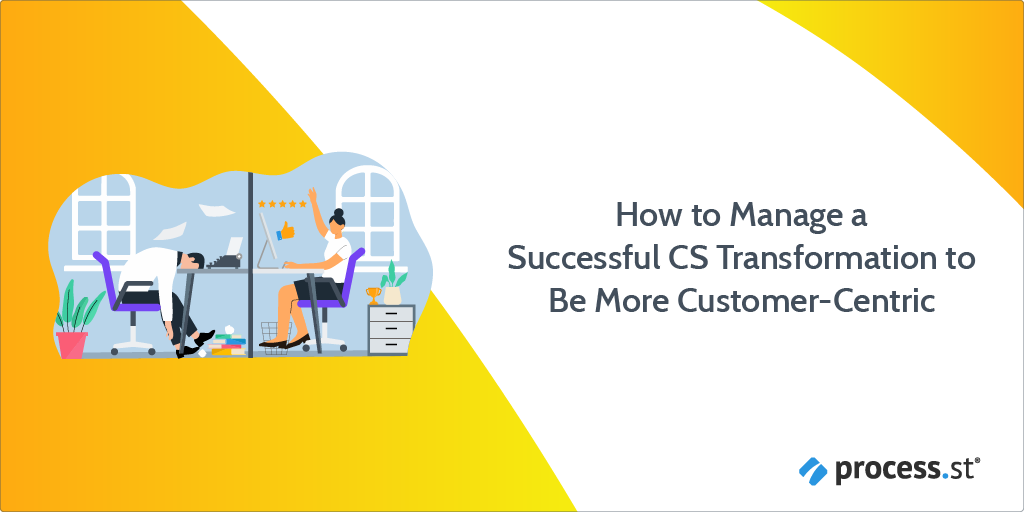 A recent Deloitte study found a mere 30% of respondents stated customer success was a strategic priority by the board of directors. Only 26% reported official business communications to regularly mention customer success.
A recent Deloitte study found a mere 30% of respondents stated customer success was a strategic priority by the board of directors. Only 26% reported official business communications to regularly mention customer success.
At Process Street, we find this concerning. Technological advancements and the rise of Industry 4.0 are altering the business landscape. Businesses are facing new pressures, with changing customer demands and expectations as the biggest catalyst altering how business is done. To respond, organizations need to focus on customer success (CS).
Businesses need to lead a successful customer success transformation, one that means they’re more customer-centric. In this Process Street article, I explain how organizations should do this in three simple steps.
- Why we need to think differently about customer success
- The companies leading in customer success are making a customer-centric transition
- 3 steps to manage your customer-centric transition
With that said, let’s jump straight to it!
Why we need to think differently about customer success
Technology – specifically the interrelationships between Artificial Intelligence (AI), big data, and the Internet of Things (IoT) – is changing the business landscape. You’re probably responding as many organizations do, focusing efforts on market analysis to adopt new technologies as they come into the playing field.
And why not? Technology brings many benefits, for instance (as outlined by Kathleen M. Wilburn and H. Ralph Wilburn):
- Technology means businesses can do more with less.
- Technology decreases the time from product idea to product creation, and then to customer delivery using fewer workers.
- Technology cuts costs with automation and robotics replacing humans who need wages and benefits.
The business benefits of technology are something I’ve discovered first-hand. I had the pleasure of working with professor Erkko Autio from Imperial College London, looking into the concept of lean internationalization. That is, we concluded technology gave organizations a sales advantage, improved business flexibility, enhanced IP protection, and allowed organizations to experiment in and enter new markets.
Erkko Autio expanded on our results, stating digitization attenuates location specificity, cross-border information asymmetries, and new venture-specific inhibitors of international expansion.
The conclusion is clear, technological advancement is delivering many benefits for businesses, creating a new industry dubbed as Industry 4.0.
Yet, despite these advantages, why is it predicted that ~50% of S&P 500 firms will be replaced over the next 10 years due to digitization?
It’s easy to think that technology is the biggest catalyst transforming organizations globally. That’s why many businesses are keeping technology at the center of their transformative response to Industry 4.0. But reports suggest that this is an incorrect approach – which may explain why 50% of S&P firms are failing to reinvent themselves appropriately.
Instead, companies should be concentrating on their customer success department. You see, the biggest catalyst driving organizational change isn’t technology directly, but the changing customer demands and expectations as a result of technological advancement and Industry 4.0.
Businesses need to leverage new digital touchpoints
To successfully ride this wave of change, companies must continuously evaluate how digital disruption is changing customer behavior. Organizations need to rethink their customer engagement model to leverage disruptive technologies. They need to redesign employees’ roles to form a customer success (CS) capability, one that maximizes customer value and enhances the customer’s experience. Businesses need to be more customer-centric.
Digitization will create digital customer touchpoints. Leveraging on this, businesses need to collect data from the real world, then analyze that data to provide real-time customer experiences that are contextualized, personalized, and data/usage driven.
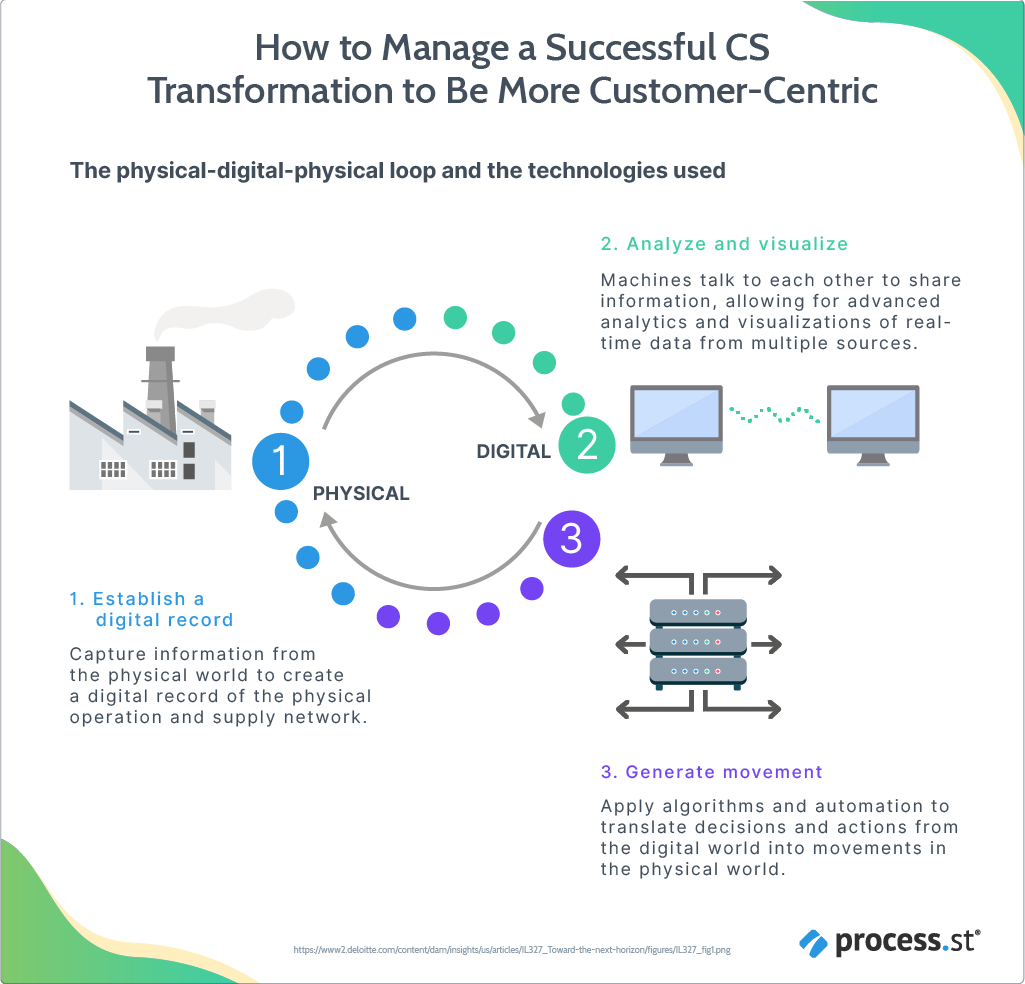
It’s the customers who are driving fundamental changes in business
Customers are driving key market changes as a result of business digitization. These changes include:
- Outcome-based services: Customers are demanding an outcome-based service, where they work with the provider to mutually agree on specific outcomes. These outcomes must be measurable, attainable, and designed to ensure customer success. Accountability is placed on value creation.
- Real-time data access: Allowing customers to track progress towards their goals and business outcomes.
- Increased complexity: As a result of connected devices and multiple vendors.
- Remote delivery: Services and support are provisioned remotely.
How can companies adapt to these market changes?
To answer that question, let’s take a look at how top companies are reacting to these market changes.
The companies leading in customer success are making a customer-centric transition
Companies leading in customer success have common elements to their approach – they’re customer-centric.
How have they successfully made this customer-centric transition?
Let’s take a look and find out, shall we?
Customer success transformation case study #1: Adobe

Up until 2008, Adobe was doing well with its perpetual-license software model. However, the 2008 recession hit the company hard as corporate spending slowed. Once more, Adobe discovered that buyers were reluctant to purchase new software versions because what they had worked well enough.
Reacting to these pressures, Adobe announced it would move away from selling products as a perpetual-license software, towards delivering a cloud-based subscription service. Using this model, customers paid a subscription fee instead of an outward investment cost. However, this move was product-focused and customers were outwardly critical of this change.
In reaction, Adobe altered its strategy to one that focused on the customer. Adobe wanted to know what the customers wanted and react accordingly. From their research, Adobe concluded that they needed a product that was materially different and delivered an entirely new value. This led to the birth of Adobe Creative Cloud.
With Adobe Creative Cloud, customers could store content in the cloud and co-collaborate using the platform. By the end of 2017, Adobe Creative Cloud grew to a $4.2 billion business.
Focusing on the customer’s needs, Adobe Creative Cloud bloomed.
Customer success transformation case study #2: Process Street
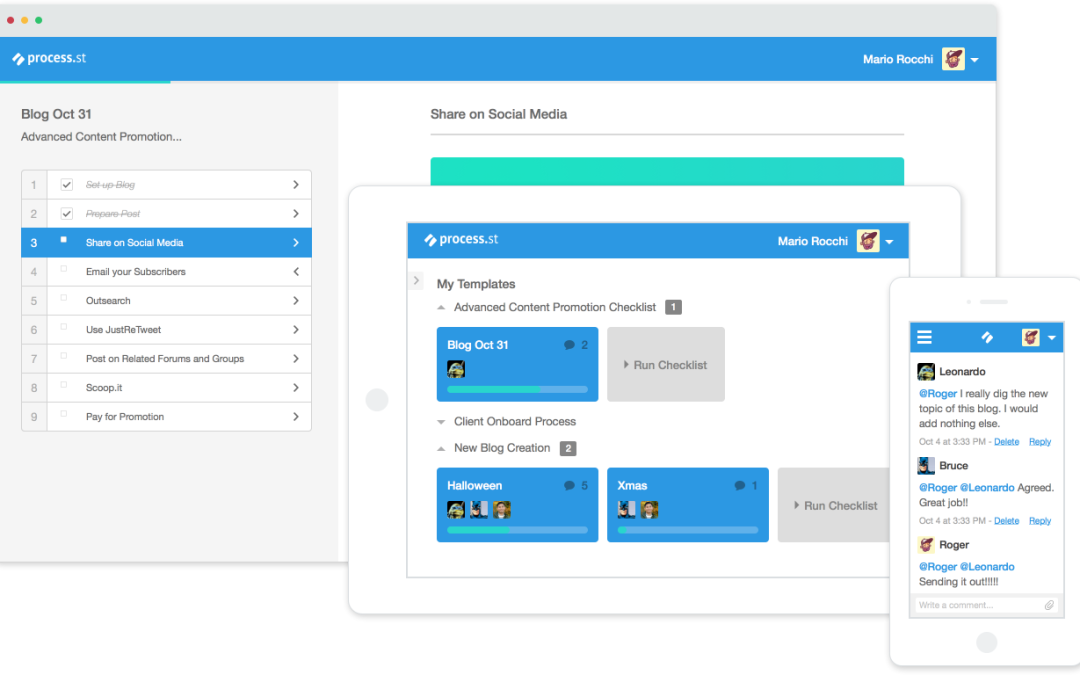
At Process Street, we put our customers at the heart of our operations. We show our users how they can solve their problems using our service.
Process Street is a no-code workflow documentation software, designed to help organizations keep track of their work, manage their business processes and automate repetitive tasks. Business workflows are documented in Process Street‘s cloud-based platform. We help our customers through the evaluation stage of the sales cycle by showing them active workflows and explaining how they’re built out.
However, acting in a customer-centric way, we knew that during the evaluation phase, most people don’t want to talk to a sales team representative. With that in mind, we designed a new customer success team that was solely dedicated to putting the customer at the center of everything we do. This team helps our users solve their biggest pain points, offering advice and the technical know-how to build out even the most complex of processes.
As you can tell, both Process Street and Adobe put the customer first. They are examples of companies that have undergone a successful customer-centric transformation. And below details the secrets to how we, Adobe, and other top customer-centric organizations have done this.
3 steps to manage your customer-centric transition
To be successful, transitioning to become more customer-centric requires progression across three key elements.
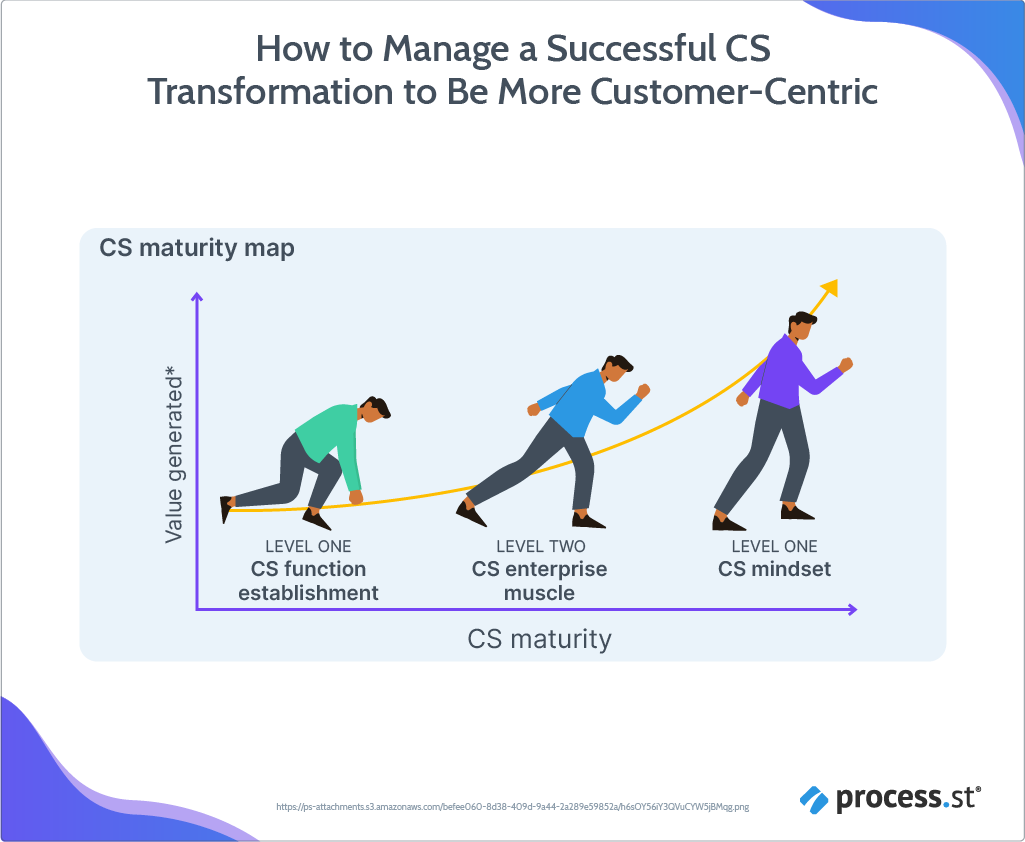
- Establish a strong customer success function: One that owns and maintains ongoing customer value and realization. One that takes accountability for driving adoption, retention, and expansion.
- Build a cross-functional engagement model: An engagement model is built with the customer in mind. The customer success team delivers insights upon which other functions act, aligning their CS outlook with the company’s overall vision.
- Establish a customer-first mindset throughout your organization: Making customer success part of an organization’s DNA is vital to truly transition to be customer-centric. At this level, customer success is imperative enough to be given a C-suite seat and is part of the regular board agenda. The value created is not only for the company (value capture) but also for the customer (value creation).
Step #1: Establish a strong customer success function
To begin your customer-centric transition, reflect on the importance of CS as a foundational element to an organization’s journey. In this, consider the following three questions:
- How would you ensure that your customers can achieve maximum value from your offering?
- How can you capitalize on the value realized by your customers?
- What can you enhance to be more aligned with the customer-centric digital transformation?
A strong customer success function will have the following features.
Customer success teams will sell to the right customer ✅
Create your customer profile. What are their likes and dislikes? What are their biggest pain points? Your CS team should focus on customers that meet your profiles.
To find out more on how you can create a customer profile, read: Reach the Right People & Get the Right Result With a Customer Profile.
Establish a means of preventing churn ⚠
“Customer churn is a concept used to describe how well or poorly a company keeps hold of the customers it acquires – how many stop paying vs how many become long-term customers.” – Adam Henshall, What is Churn Rate? How to Calculate Customer Churn (Definition + Meaning)
We’ve made things easy for you with this one. Use our Churn Prevention Checklist to stop high-value accounts from canceling. Simply create your free Process Street account to get started.
Key checklist features:
- Stop Tasks to ensure all the necessary steps to prevent customer churn are executed with effect.
- Task permissions to ensure only the relevant members of your customer success team can complete the churn prevention checklist.
- Conditional logic to cater the checklist to your needs. By answering a series of questions, you can document the relevant information about the specific account in question, which will influence what workflow steps will be presented to prevent customer churn.
Click here to access our Churn Prevention Checklist!
Make sure your customers are widely successful
You want to ensure your customer success functions revolve around the customer. Think about your customer’s goals: What do they want to achieve by using your product/service? What stage are your customers operating at presently? Where are your customers heading?
For your customers to be successful, you need an effective means of measuring customer success. For that, use a customer success vector.
For more information on customer success vectors and how to use one, read: 5 Tips to Make Your Customer Success Vectors Actual Vectors (KSIs Not KPIs).
Monitor and manage your customer’s health
Customer health scoring isn’t only about measuring NPS. It’s an aggregate metric indicating what’s happening in your customer accounts early enough for you to act appropriately.
To find out how you can calculate a customer health score, read: How to Have a Customer Health Score Beyond Just NPS (Which We Know 46% of You Use!).
Be metrics-driven
You’ll need metrics that measure customer and user behavior, for example:
- NPS;
- Number of logins;
- Product/service feature use.
In addition, use metrics that measure business outcomes, for example:
- Gross retention;
- Net retention;
- Expansion;
- Logo retention;
- Customer satisfaction.
Step #2: Build a cross-functional engagement model
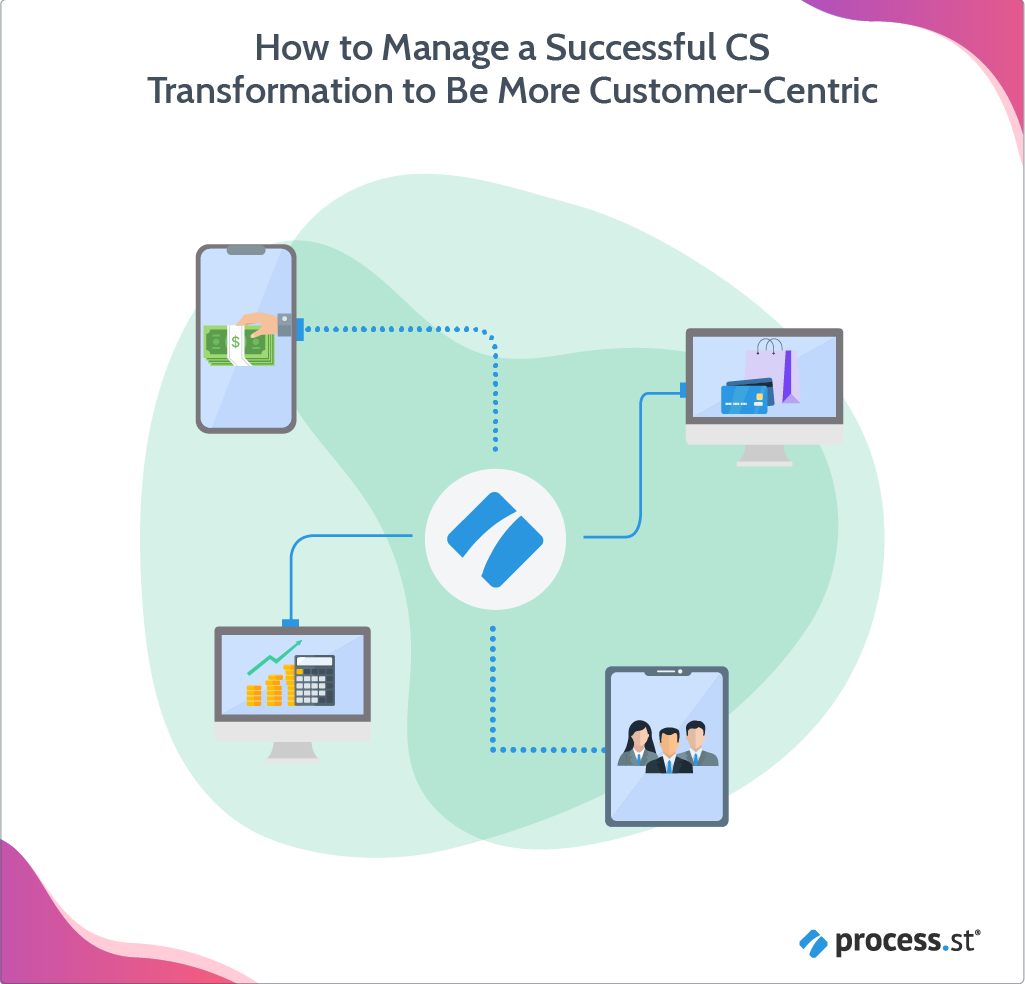
Once you’ve built a strong customer success function, the next step is for your organization to embrace customer-centricity. You want to ensure CS becomes part of your enterprise muscle. To achieve this, make sure a CS representative is at the CEO table and on the board’s agenda. By placing customers at the center of an organization’s strategy, leaders can focus and give direction to your overall digital transformation.
Customer centricity needs to trickle down to all levels of your organization and across departments. A cross-functional approach is vital for helping organizations build a customer-centric mentality. It unites departments with a common goal of finding out the customer’s needs and helping them achieve their goals.
A big aspect of delivering a cross-functional engagement model is breaking down organizational silos by integrating big data.
Cloud computing, cheaper storage, and technological advancements mean organizations are using multiple applications, which generate a huge amount of data. This introduces the risk of data silos existing between these applications, limiting cross-functional engagement, collaboration, and teamwork. What’s needed is a means of connecting this data, and therefore the departments/teams.
This is where Process Street comes in.
Every business operates using a series of workflows. I like to think of business workflows as the veins feeding an organization, connecting all units, teams, and departments. When we’re talking about data, workflows will capture data from one department, which may well be passed to another department/team for them to complete their workflows. Hence by documenting workflows, your also documenting business data breaking down data silos.
Once more, you can connect your Process Street account – containing your documented workflows – with other applications such as your CRM. Once connected, you’ll run a given Process Street workflow, document the relevant customer information, and then pass this information to your CRM (plus other applications)- which you can do automatically at a click of a button.
Find out more about the type of integrations you can execute using Process Street by reading our integrations help page.
Your documented workflows in Process Street connect and integrate your different applications/data sources. This big data integration breaks down data silos meaning companies can gain key analytical insights that’ll drive customer success.
The majority of businesses effectively execute step #1 of their customer-centric transition but fail at step #2. As observed, a majority of companies are data-rich but information poor. In other words, they lack to kind of actionable information and analytical ability to improve their customer-success function. That is, they fail to break down data silos and establish a cross-functional engagement model. With Process Street, you can avoid such failings, and continue on your path to customer-centricity.
Step #3: Establish a customer-first mindset throughout your organization
Your final key step is driving a customer-centric mindset across your organization, which requires a definitive change in organizational culture. This can be the most difficult – yet the most rewarding – part of your customer-centric journey.
Companies able to focus and execute this step will have the customer-centric approach running through the heart of an organization’s DNA.
Check out Process Street‘s resources on how you can effectively manage organizational change to be more customer-centric. The resources below come with free change management workflows, that will guide you through the process guaranteeing customer-centricity at the heart of everything you do.
- 8 Critical Change Management Models to Evolve and Survive
- How to Apply 7 Change Management Principles to Your Remote Workforce
- 9 Free Templates for a Successful Change Management Plan
Reacting to Industry 4.0 by completing your CS maturity map
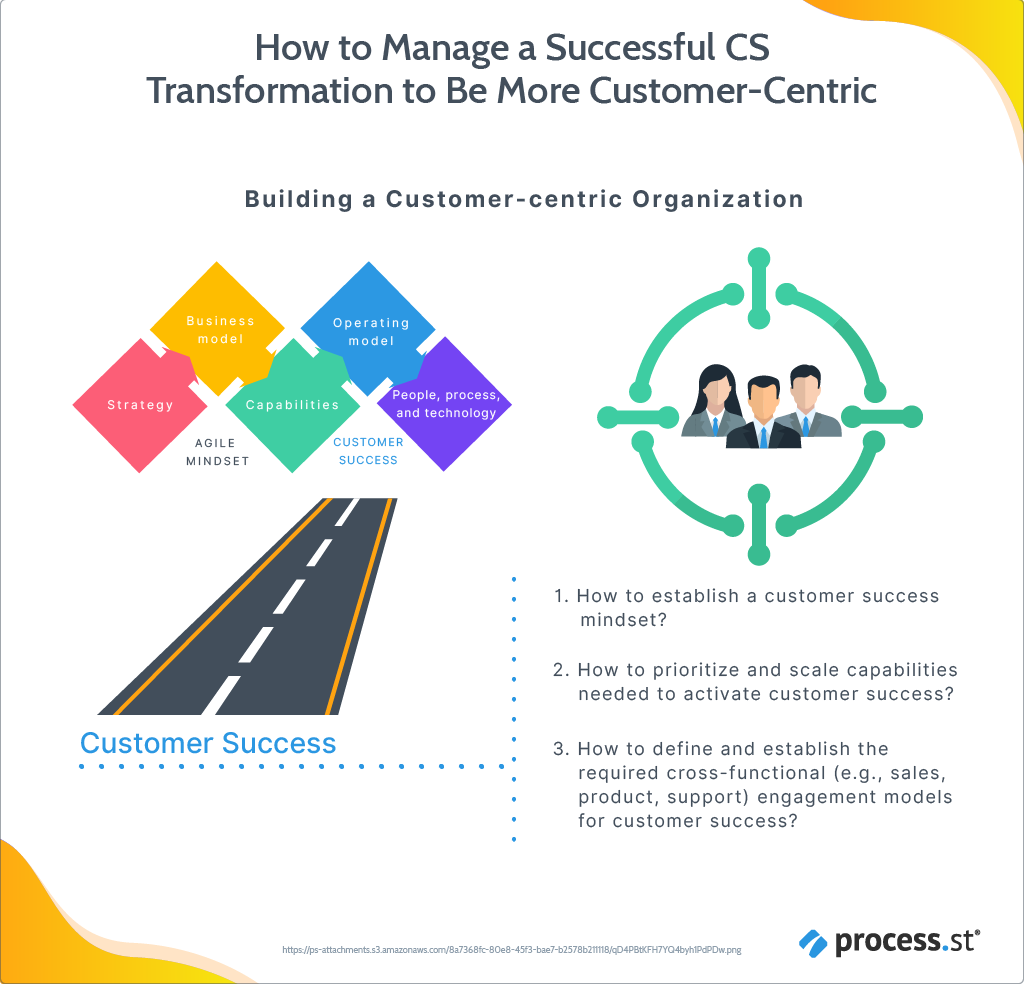
Technological advancements are altering customer expectations and demands. To survive, organizations need to adapt their operations to ensure customer-centricity runs at the heart of the business.
By completing the 3 steps given in this article, you’ll move your CS department towards a mature customer-centric mindset by driving the required cultural shift. You’ll scale your customer success functions, prioritizing those that put the customer at the center of everything you do. And finally, you’ll define and establish the required cross-functional engagement model using Process Street to connect your data and departments.
For more information on how to operate an effective customer success department, check out our relevant resources given below:
- Complete Guide to Customer Success for SaaS Companies
- Customer Success 2.0: The Essential Software Stack to Execute McKinsey’s Model
- The Secret to Success: Process Street’s Customer Success Team Tell All
- Customer Success Operations: How to Build Repeatable Processes to Scale and Grow
How have your made your customer success department more customer-centric? What processes have you put in place to ensure the customer runs at the heart of every decision you make? Let us know in the comments below!







Jane Courtnell
Hi there, I am a Junior Content Writer at Process Street. I graduated in Biology, specializing in Environmental Science at Imperial College London. During my degree, I developed an enthusiasm for writing to communicate environmental issues. I continued my studies at Imperial College's Business School, and with this, my writing progressed looking at sustainability in a business sense. When I am not writing I enjoy being in the mountains, running and rock climbing. Follow me at @JaneCourtnell.